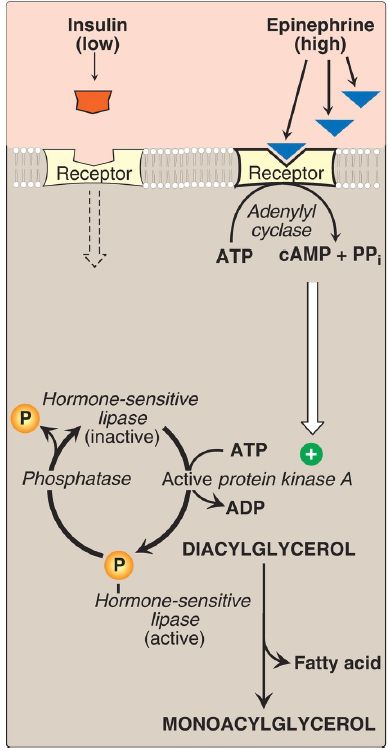
Fatty Acid Release from Fat
 المؤلف:
Fatty Acid Release from Fat
المؤلف:
Fatty Acid Release from Fat
 المصدر:
Lippincott Illustrated Reviews: Biochemistry
المصدر:
Lippincott Illustrated Reviews: Biochemistry
 الجزء والصفحة:
الجزء والصفحة:
 11-10-2021
11-10-2021
 2305
2305
Fatty Acid Release from Fat
Fatty acids stored in WAT, in the form of neutral TAG, serve as the body’s major fuel storage reserve. TAG provide concentrated stores of metabolic energy because they are highly reduced and largely anhydrous. The yield from the complete oxidation of fatty acids to CO2 and H2O is 9 kcal/g fat (as compared to 4 kcal/g protein or carbohydrate).
The mobilization of stored fat requires the hydrolytic release of FFA and glycerol from their TAG form. This process of lipolysis is achieved by lipases. It is initiated by adipose triglyceride lipase (ATGL), which generates a diacylglycerol that is the preferred substrate for hormonesensitive lipase (HSL). The monoacylglycerol (MAG) product of HSL is acted upon by MAG lipase.
1. Hormone-sensitive lipase regulation: HSL is active when phosphorylated by PKA, a cAMP-dependent protein kinase. cAMP is produced in the adipocyte when catecholamines (such as epinephrine) bind to cell membrane β-adrenergic receptors and activate adenylyl cyclase (Fig. 1). The process is similar to that of the activation of glycogen phosphorylase . [Note: Because ACC is inhibited by hormone-directed phosphorylation, when the cAMP-mediated cascade is activated , fatty acid synthesis is turned off and TAG degradation is turned on.] In the presence of high plasma levels of insulin, HSL is dephosphorylated and inactivated. Insulin also suppresses expression of ATGL. [Note: Fat droplets are coated by a protein (perilipin) that limits access of HSL. Phosphorylation of perilipin by PKA allows translocation and binding of phosphorylated HSL to the droplet.]

Figure 1: Hormonal regulation of diacylglycerol degradation in the adipocyte. [Note: Triacylglycerol is degraded to diacylglycerol by adipose triglyceride lipase.] cAMP = cyclic adenosine monophosphate; PPi =pyrophosphate; ADP = adenosine diphosphate; = phosphate.
2. Fate of glycerol: The glycerol released during TAG degradation cannot be metabolized by adipocytes because they lack glycerol kinase. Rather, glycerol is transported through the blood to the liver, which has the kinase. The resulting glycerol 3-phosphate can be used to form TAG in the liver or can be converted to DHAP by reversal of the glycerol 3- phosphate dehydrogenase reaction illustrated in Figure 2. DHAP can participate in glycolysis or gluconeogenesis.
 Figure 2: Pathways for production of glycerol 3-phosphate in liver and adipose tissue. [Note: Glycerol 3-phosphate can also be generated by glyceroneogenesis.] NAD(H) = nicotinamide adenine dinucleotide; ADP = adenosine diphosphate.
Figure 2: Pathways for production of glycerol 3-phosphate in liver and adipose tissue. [Note: Glycerol 3-phosphate can also be generated by glyceroneogenesis.] NAD(H) = nicotinamide adenine dinucleotide; ADP = adenosine diphosphate.
3. Fate of fatty acids: The FFA move through the cell membrane of the adipocyte and bind to serum albumin. They are transported to tissues such as muscle, enter cells, get activated to their CoA derivatives, and are oxidized for energy in mitochondria. Regardless of their levels, plasma FFA cannot be used for fuel by red blood cells (RBC), which have no mitochondria. The brain does not use fatty acids for energy to any appreciable extent, but the reasons are less clear. [Note: Over 50% of the fatty acids released from adipose TAG are reesterified to glycerol 3- phosphate. WAT does not express glycerol kinase, and the glycerol 3- phosphate is produced by glyceroneogenesis, an incomplete version of gluconeogenesis: pyruvate to OAA via pyruvate carboxylase and OAA to phosphoenolpyruvate (PEP) via phosphoenolpyruvate carboxykinase.
The PEP is converted (by reactions common to glycolysis and gluconeogenesis) to DHAP, which is reduced to glycerol 3-phosphate. The process decreases plasma FFA, molecules associated with insulin resistance in type 2 diabetes and obesity .
 الاكثر قراءة في الكيمياء الحيوية
الاكثر قراءة في الكيمياء الحيوية
 اخر الاخبار
اخر الاخبار
اخبار العتبة العباسية المقدسة


